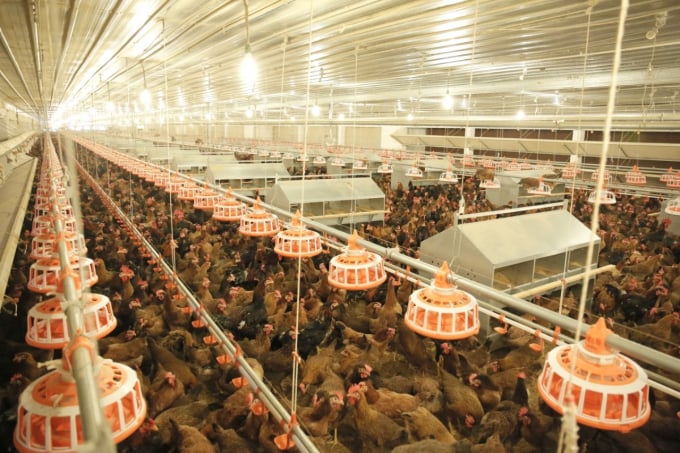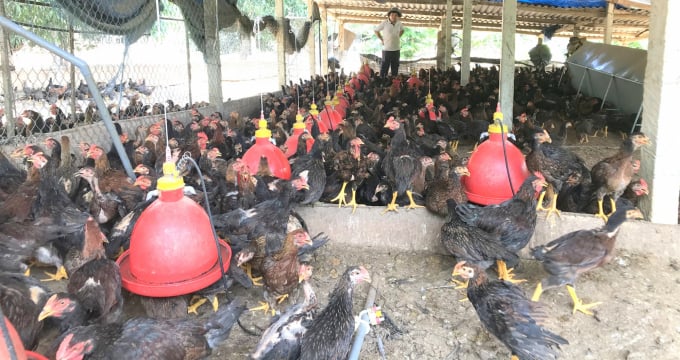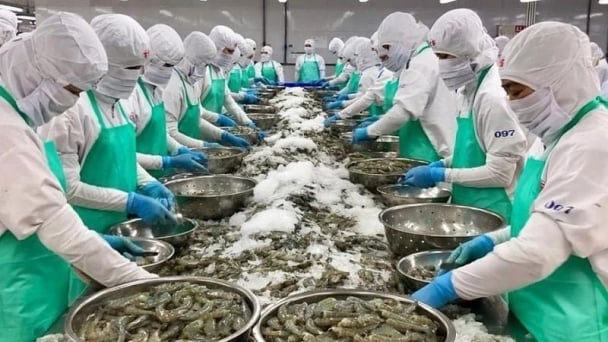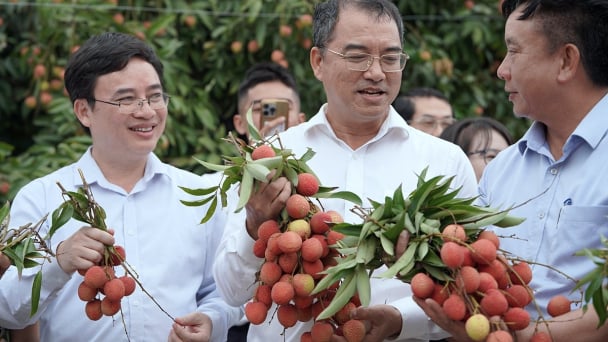June 4, 2025 | 13:38 GMT +7
June 4, 2025 | 13:38 GMT +7
Hotline: 0913.378.918
June 4, 2025 | 13:38 GMT +7
Hotline: 0913.378.918
Since the mid-2021, the enterprises operating in breeding chicken industry in Binh Dinh province have nearly come to a standstill. Binh Dinh had two well-known breeding chicken enterprises including Minh Du Breeding Poultry Company Limited (Minh Du Company) located in Tuy Phuoc district and Cao Khanh Company Limited (Cao Khanh Company) situated in Phu Cat district.

Parent chickens are raised at a facility of Minh Du Company. Photo: V.D.T.
Minh Du Co.Ltd., has several facilities sized over 150 hectares in total scattering in Phuoc Nghia commune (Tuy Phuoc district) , Canh Vinh commune (Van Canh district) and Nhon Tan commune (An Nhon town). These facilities are equipped with modern Europe technology hatchers. On average, Minh Du Company provides around 100 million one-day-old chicks to the market every year, making up 20% of the national market shares, making it one of the four biggest colored chicken companies of Vietnam and a leading enterprise in terms of free-range chickens. Meanwhile, Cao Khanh Company provides 35-40 million breeding chickens to the market every year. Even though, in the mid-2021 when the Covid-19 pandemic spread widely and social distancing measures were taken in many localities, broiler chickens couldn't be sold leading to a "freeze" in breeding chicken market.
According to Cao Van Khanh, Director of Cao Khanh Company, during that period the company's supply of breeding chickens to the market slumped by 90%. The prices were at low levels, ranging from VND5,000-6,000/ one-day-old chick. The amount the company earned couldn't pay its employees' wages. A lot of small and medium-sized breeding chicken companies in Binh Dinh had to suspend their operations.

A hatching facility of Minh Du Company. Photo: V.D.T.
Since the Lunar New Year 2022, the breeders nationwide have strongly resumed their operations. Accordingly, demand for breeding chicken has been increasing and Binh Dinh's breeding chicken enterprises have worked at full capacity to meet the market demand.
According to Huynh Ngoc Diep, Director of Binh Dinh Sub-Department of of Animal Health, since the Lunar New Year 2022, the prices of meat poultry and cattle have been stable. In addition, with the peak demand for pork and meat chickens during the Lunar New Year supply shortages are now happening, accelerating the speed of herd restocking in Binh Dinh.
Meat chicken prices have been now at nearly VND50,000 per kilo, especially the prices of free-range chickens raised from breeding chicks provided by Minh Du and Cao Khanh companies are currently at VND58,000-60,000 per kilo. As a result, breeding chicks are sold well with the prices two times higher than those during the Covid-19 outbreak. Currently, a one-day-old chick are being sold by Cao Khanh and Minh Du Companies for VND12,000.
"Over the past time, although bird flu outbreaks have been reported in the neighboring provinces, Binh Dinh have been not affected yet; therefore the breeders here are accelerating chicken herd restocking to meet the market demand," Diep said.

Deputy Minister of the MARD Phung Duc Tien (second from the right) visits a facility of Minh Du Company. Photo: V.D.T.
At the beginning of 2022, the leaders of the People's Committee, the Department of Agriculture and Rural Development and the Sub-Department of Animal Health of Binh Dinh province visited and inspected the production situation of Minh Du Company. Le Minh Du, Minh Du Company’s director excitedly said the company was seeing a great recovery.
Minh Du Company has recently seen order spikes in the company’s breeding chickens. In spite of owning a total herd of 680,000 chickens including 5,000 great grand parents,50,000 grand parents and 625,000 parent chickens which produce hundreds of millions of breeding chickens, Du was afraid that the company couldn’t provide enough breeding chickens to the breeders nationwide in the near future.
Du explained a great number of breeding chicken facilities had to stop their operations during the Covid-19 outbreak because of frozen market. At present, as the poultry industry is recovering from disruption, the enterprises that could survive during the pandemic are seeing that their capacity can’t match demand.

Broiler chickens are sold well. Photo: V.D.T.
“2021 indeed was a bad year for breeding chicken industry. Even so, our company still tried out best to maintain and develop the flocks of grandparent and parent chickens. So, as the breeding chicken market has got warmer we could operate at full capacity to meet the market demand. We are now running out of breeding chickens. The prices are also getting higher,” Du said.
Meanwhile Cao Van Khanh, Cao Khanh Company’s director said the company’s operation was recovering gradually although it could provide only 70% of its production to the market compared to average volume in previous years. However it was a good sign after a long period of stalemate.
Currently demand for meat chickens is increasing across the country. In the second half of 2021 most of poultry breeders left their barns empty because of deadlock in broiler chicken market due to the Covid-19 pandemic, in addition to rising costs of animal feed. After the Lunar New Year 2022, the market has been in short of meat chicken. This is a great motivation for farmers to restock chicken herds.

Minh Du company is operating at full capacity to meet the market demand for breeding chickens. Photo: V.D.T.
Seeing promising prospect for the poultry industry, Cao Khanh Company is strengthening linkages with breeders across the country to raise 500,000 chickens. Cao Khanh Company will provide its partner farmers all breeding chickens, feed for the whole process of raising meat chickens. Its partner farmers only need to have barns and spend time and effort to take care of chickens. A small-scale farm can raise about 10,000 chickens while the larger ones can rear 30,000 or 50,000 chickens. The company will pay these farms to take care of chickens. Under this linkage system farmers have more stable incomes compared to their smallholder counterparts. On average, a couple of husband and wife, each can earn over VND10 million per month.

Farmers are accelerating chicken herd restocking after a long period of stalemate. Photo: V.D.T.
“The enterprise –farmer linkage system requires the enterprise to have economic potential. It needs up to VND120 billion to raise 1 million chickens in this system. The enterprises like us can’t manufacture animal feed, so when feed prices spiked, the prices of chickens go up too, making us less competitive in the market,” said Cao Van Khanh.
“Most of animal feed manufacturers, especially foreign enterprises are now raising meat chickens. They can raise up to tens of millions of chickens at once. Because they don’t have to buy feed they can sell their chickens for lower prices and still make a profit. We can’t compete with them,” said Cao Van Khanh, Director of Cao Khanh Company Limited.
Translated by Mai Tham

(VAN) Vietnam's pepper industry is looking forward to the final tariff decision in order to sustain its robust presence in the United States, the country's biggest pepper market.

(VAN) The U.S. is the largest market for Vietnamese cashew nuts. However, when exports to the U.S. encounter difficulties due to reciprocal tariffs, Vietnamese cashews still have many other potential markets.

(VAN) Reciprocal tariffs present a significant obstacle to Vietnam's wood exports to the United States; however, domestic wood businesses are endeavoring to preserve their market share in this critical market.

(VAN) Businesses in Vietnam are attempting to export rice to the United States ahead of the implementation of reciprocal tariffs, while remaining their optimism regarding this critical market.

(VAN) From containers of cashew nuts, shrimp to in-depth technical dialogues, agricultural cooperation between Vietnam and the United States is entering a period of sustainable and two-way development.

(VAN) After the talks on May 28, Vietnam successfully exported its first batch of frozen durians to China, marking a new milestone in agricultural trade cooperation between the two countries.

(VAN) Several major companies, such as Red Dragon and Ameii Vietnam, have signed purchasing agreements for the 2025 season, targeting markets including Japan, the United States, and the EU.